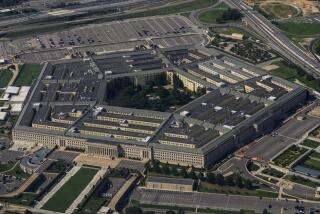U.S. troops to shift to advisory role in Afghanistan
- Share via
Reporting from Kabul, Afghanistan — The top commander in Afghanistan said Tuesday that U.S. forces would begin a major shift next year to an advisory role, in hope of building up the Afghan army’s fighting skills and gradually extricating American and allied units from a combat role.
Marine Corps Gen. John Allen told reporters in Kabul that, starting in 2012, small teams of U.S. advisors would be sent to Afghanistan to live and fight with Afghan army units, with the aim of enabling large U.S. combat units to gradually step back from the lead role in providing security and to withdraw completely by the end of 2014.
But the U.S. could face difficulty in reducing its combat role on such a rapid timetable. Afghan units remain plagued by personnel and operational problems, and large areas of the country still face stubborn insurgency.
Allen acknowledged that U.S. and Afghan forces would have to step up offensive operations in eastern Afghanistan next year, which has remained an insurgent stronghold even as security has improved in the south.
White House officials support a shift toward an advisory effort because it will be a visible sign that the U.S. is disengaging from the decade-old war as President Obama campaigns for reelection in part on his success in wrapping up the conflicts in Iraq and Afghanistan.
Allen has been privately discussing the move in Afghanistan with Pentagon and White House officials for months, but Tuesday was the first time he has publicly described his timetable for launching the advisory effort. The move is also aimed at shoring up the continuing efforts of other NATO members in Afghanistan, as support for keeping combat troops in the country through 2014 has plummeted.
Allen and his staff would help Afghan forces operate independently by assigning them U.S. personnel to provide day-to-day advice on planning operations, as well as calling in artillery, close air support and, if necessary, U.S. helicopters to evacuate the wounded.
“We are going to probably see the introduction … of some advisory forces that will begin to support the [Afghan] forces from inside and that will in many respects be a preview of how we’ll see our forces postured in the years to come,” Allen said.
The general made his comments the day Defense Secretary Leon E. Panetta arrived in Afghanistan for talks with commanders and Afghan officials. Panetta is on a weeklong trip to multiple war zones, and Tuesday morning stopped in Djibouti to see U.S. troops at Camp Lemonier, a base for U.S. military operations in Yemen and Somalia.
Later in the week Panetta is to visit Iraq for a ceremony marking the end of the U.S. military mission there, and will also visit Libya.
The U.S. is still trying to repair relations with Pakistan after U.S. helicopter attacks on a border post in late November killed two dozen Pakistani troops. Pakistan has closed border crossings through which NATO shipped about 30% of its supplies, forcing the U.S. to rely more heavily on northern supply routes through Russia. Allen said he had spoken with Gen. Ashfaq Kayani by telephone Monday, but he declined to speculate on when the crossings might be reopened.
There are 94,000 U.S. troops in Afghanistan, a number scheduled to drop to 91,000 by the end of the month and to 68,000 by the end of next summer.
With the U.S. drawdown already underway, Western troops have begun handing over security responsibilities to Afghan forces in some parts of the country, and some of those areas have seen upticks in attacks by the Taliban and other insurgents.
In Badghis province, in the northwest, Afghan police Tuesday shot a would-be suicide bomber who tried to strike a NATO base in Qala-i-Naw, the provincial capital. Badghis, where insurgent attacks are relatively rare, is on a list of areas designated for the next phase of security transfers. Most of the NATO troops in Badghis are Spanish, and Spain’s government has said it will begin withdrawing its forces next month.
Allen said he planned to request that the Pentagon send advisor teams composed of mid-career officers and senior noncommissioned officers. Over time, the mix of U.S. forces in the country would gradually shift away from infantry units trained to clear and hold areas of insurgents and toward advisors and so-called enablers, including helicopter units, logisticians and other support personnel who will assist Afghan soldiers.
He said the exact timing of the shift and the number of advisors to be brought in initially had not been decided. But he made it clear that the advisory effort would grow substantially in coming years and gradually become the main mission for U.S. forces remaining in the country.
“The crossover point” where the U.S. mission makes the transition from combat to mostly advising “remains to be determined,” Allen said.
More to Read
Sign up for Essential California
The most important California stories and recommendations in your inbox every morning.
You may occasionally receive promotional content from the Los Angeles Times.













